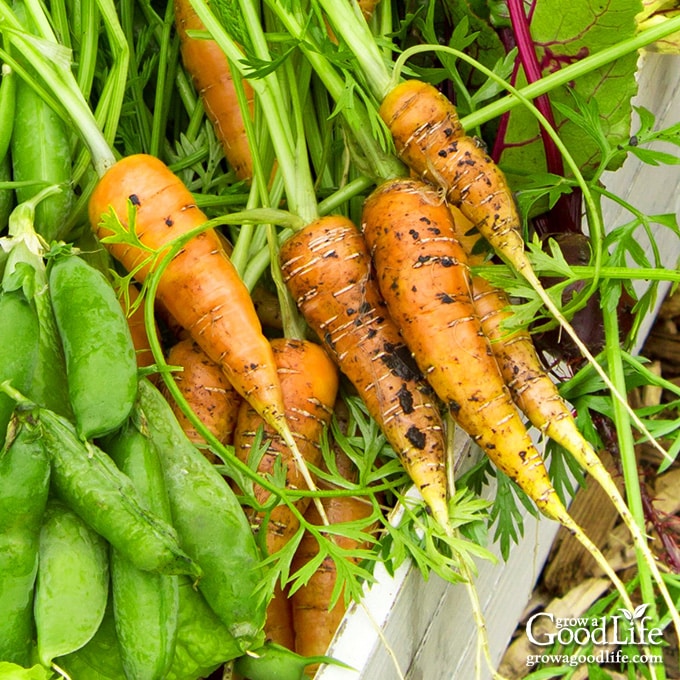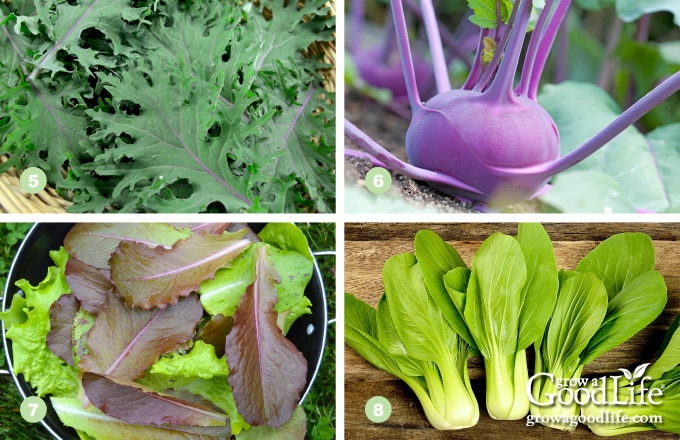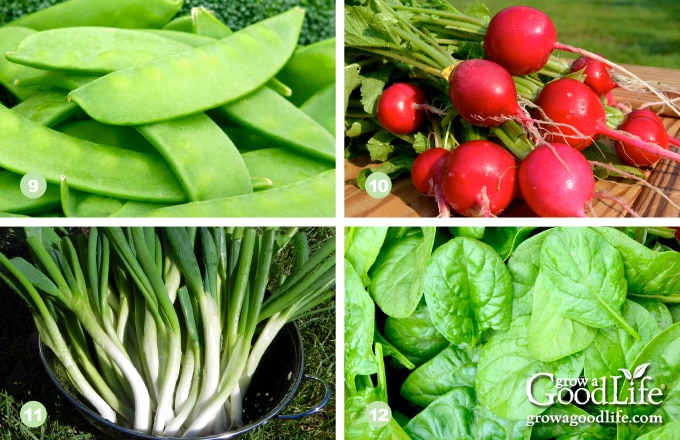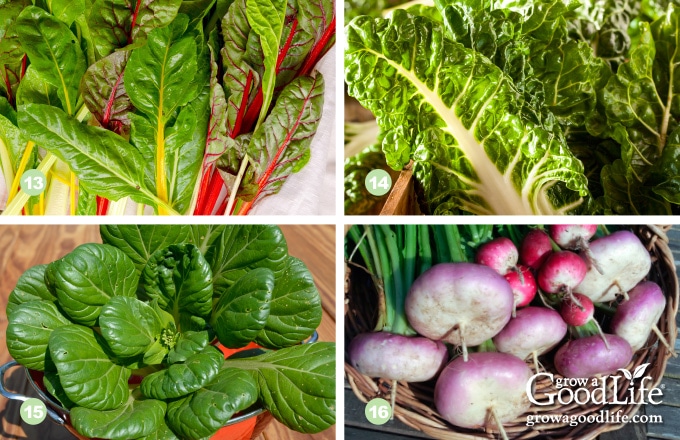15 Fast Growing Vegetables for Spring
This post may contain affiliate links, which means that I may receive a commission if you make a purchase using these links. As an Amazon Associate I earn from qualifying purchases.
Spring is the perfect time for gardeners to get a head start on the growing season. By planting cool-season, fast-growing vegetables, you can maximize your yield and enjoy fresh produce sooner.

After the long winter, most gardeners are eager to start planning the vegetable garden. In addition, it is great to accomplish some outside garden cleanup once the snow melts and the days grow longer.
You can also get a jump-start on enjoying fresh harvests by sowing cool-season crops that will grow and produce quickly.
Cool-season vegetables are ones that grow and thrive during the shorter days and colder temperatures of early spring and fall. These cold-tolerant crops also grow quickly, so you can enjoy fresh harvests in no time!
Even though the heat of summer is a ways away, there are still many vegetables you can sow early as soon as the ground can be worked in spring. Some can be harvested in as little as 30 days!
Enjoy the Benefits of Spring Gardening
Growing early spring crops can be a great way to kick off your gardening season and enjoy fresh produce early in the year. By taking advantage of the cooler temperatures and potentially avoiding some pest issues, you can set yourself up for a successful growing season. Here are some benefits of planting a spring vegetables garden:
- Maximizing growing season: Growing early spring crops can help you maximize your growing season by starting your garden earlier and enjoying fresh produce sooner.
- Cooler temperatures: Early spring crops tend to prefer cooler temperatures and can thrive in the mild conditions of early spring. This can be beneficial as it allows for healthy growth, resulting in better-tasting produce.
- Less pest pressure: Early spring crops can also benefit from less pest pressure than later season crops. This is because many pests and diseases tend to be more active later in the growing season when temperatures are warmer. By planting early, you can avoid some of these issues.
- Nutritional value: Early spring crops can be packed with nutrients as they are often grown in cooler weather and have more time to develop their flavors and nutrients. This can result in higher levels of antioxidants, vitamins, and minerals in the produce, which can be beneficial for overall health.
- Variety: Early spring crops often include a wide variety of vegetables that are well-suited to cooler temperatures. This can allow you to diversify your garden and try new vegetables that you may not be able to grow in the summer months. I love trying different leafy greens to add texture, color, and flavor to salads and Asian greens for more variety in stir-fry recipes.
So, as you think of springtime gardening, remember that many cool-season vegetables can be planted, harvested, and enjoyed even before the summer heat arrives.
Spring Gardening Tips
Spring is an excellent time to start growing vegetables in your garden! A little research, garden preparation, and a collection of seeds are all you need. Here are some tips for planting an early spring vegetable garden:
Prepare the Garden Beds:
If you still need to do so, go ahead and clean up your gardening beds by pushing aside last year’s mulch to help the soil warm up, remove dead plants and weeds, and top dress with a few inches of finished compost: Tips for Tidying the Garden.
Know Your Average Last Frost Date:
The key to planning your garden is to know when the average last frost date is for your growing area. Read on for tips for finding your estimated last frost date and how to develop a seed starting and planting schedule: How to Develop a Seed Starting Schedule.
Read the Seed Package:
Most seed packages will include information on how and when to start seeds, the number of days to seed germination, and the days to harvest.
Some seeds can be started early indoors under lights and then transplanted into the garden, while others can be directly sowed into your garden beds. The seed packet will explain when to sow seeds and transplant seedlings with phases similar to the following:
- Start seeds indoors under lights # weeks before your last frost date: Some crops need a head start and should be sowed indoors. Once you have found your average last frost date, count back the number of weeks stated on the seed package. Sow seeds in seedling trays under lights, and then refer to the seed package to figure out when to transplant hardened off seedlings into the garden.
- Sow seeds as soon as the ground can be worked: After the snow melts, the soil needs a few weeks to warm up and dry out a bit. Squeeze the soil in your hands. If it stays together in a wet clump, it will need to dry out a little further. You can use a meat thermometer to check the soil temperature. Most cool-season crops will germinate when the soil temperature is around 40˚F.
- Direct sow seeds # weeks before your last frost date: Find your last frost date and count back the number of weeks indicated on the seed package.
- Sow seeds after your last frost date: Wait about a week until your average last frost date is passed before sowing seeds for these crops.
Seed packets will also note spacing requirements, height and spread at maturity, thinning instructions, growth habits, and other special considerations.
Decide How to Plant Your Seeds:
You can sow your seeds in a variety of ways. However, most spring crops can be planted by seeds sowed right in the garden in furrows, mounds, or simply by poking holes in the soil and dropping in the seeds. Here are some common methods plus suggestions for direct sowing seeds: Tips for Direct Sowing Seeds.
Some seeds will produce quicker if you start them indoors under lights and transplant them to the garden in early spring. Indoor seedlings will need to adjust to outdoor weather before planting using a process called “Hardening Off.” You can learn more about starting seeds and how to harden off seedlings in the following articles: How to Start Seedlings Indoors and How to Harden Off Seedlings Before Transplanting.
Keep the Soil Evenly Moist
After sowing seeds, water the soil well and keep it evenly moist until the seeds sprout. Take care not to overwater, as seeds will rot in waterlogged soil. Once the plants sprout and begin to grow, let the soil dry slightly between watering.
Watch the Weather:
Even though these vegetables are cold-tolerant, they can still be stunted or killed by a severe drop in temperature. Be ready to protect your plants if the weather threatens with an unanticipated freeze. Tips to Protect Your Garden from Unexpected Frost.
Harvest Frequently:
Once your plants grow, be sure to harvest your crops regularly as they reach maturity. Regular harvesting will encourage the plant to continue producing new leaves and prevent it from bolting, or going to seed too quickly. Bolting happens when the plant switches from growing foliage to making seeds. This occurs once the plants are finished their growth cycle or if they are triggered to go to seed when the weather gets too warm.
When a plant bolts, it will send up a flower stalk that will bloom and develop into seeds. Usually, the foliage turns bitter once the plant bolts. So either let the seeds mature so you can save them for next year, or pull the plants and sow something new.
15 Fast Growing Vegetables to Plant in Spring
Planting fast-growing vegetables in the spring is an excellent way to maximize your yield and enjoy fresh produce sooner. These cool-season vegetables are easy to grow and can provide a bountiful harvest in no time. From leafy greens to root vegetables and beyond, there are plenty of options to suit every taste and growing space.
Arugula
Arugula, also known as Rocket, adds a punch of peppery flavor to early spring salads and is a great addition to soups.
- When to Sow Seeds: As soon as soil can be worked. For a continuous harvest, sow seeds every 2 weeks until temperatures warm.
- Germinates: About 7 to 10 days.
- Light Requirements: Full sun to partial shade.
- Harvest: About 20 days at baby stage and 40 days full size. Begin cutting outer leaves once they are at least 2 inches long and allow the plant to continue to produce harvests.
- Arugula Varieties to Consider: Astro, Esmee, Dragons Tongue, Wild Rocket, and Uber.
Beets
Beets can be grown for fresh greens to enjoy in salads, soups, and sautéing, and tasty roots for canning, roasting, and boiling.
- When to Sow Seeds: Direct sow seeds as soon as soil can be worked. For a continuous harvest, succession sow seeds every 3 weeks until the temperatures begin to warm in late spring.
- Germinates: About 10 to 20 days.
- Light Requirements: Full sun to partial shade.
- Harvest: About 30 days for greens and 60 days for full-size roots. Pick beet greens when they are 5 inches tall. You can snip a stalk or two from each beet plant without compromising the root growth. Harvest the beetroot when they are around 2 to 3 inches in diameter.
- Beet Varieties to Consider: Detroit Dark Red, Chioggia, and Touchstone Gold.
- Learn more with our growing guide: How to Grow Beets.
Carrots
Carrots are a staple root vegetable in the garden. Choose early maturing varieties for a quick harvest. Carrots can be enjoyed in many ways, from raw in salads to boiled, roasted, and juiced.
- When to Sow Seeds: After the danger of heavy frost is past. Can tolerate light frost. Succession sow a new crop every 2 weeks until mid-summer for a continuous supply of tender young carrots.
- Germinates: About 14 to 21 days.
- Light Requirements: Full sun to partial shade.
- Harvest: About 30 days as baby carrots and 60 days full size. Carrots are edible at any size. Toss thinnings into salads and stir-fries.
- Early Carrot Varieties to Consider: Little Finger, Napoli, Mokum, and Tonda di Parigi.
- Learn more with our growing guide: How to Grow Carrots.
Collards
Collards are in the cabbage family but are much easier to grow as they endure a wider range of temperatures and growing conditions. Collard greens can be used to flavor soups and stews, or boiled, steamed, or sautéed and served as a side dish.
- When to Sow Seeds: Sow seeds outdoors as soon as soil can be worked in spring. Or start collards seeds indoors 6 weeks before your last frost date, and transplant hardened-off seedlings to the garden as early as 2 weeks before your last frost date.
- Germinates: About 10 to 21 days.
- Light Requirements: Full sun.
- Harvest: About 30 days as young greens and 70 days full size. Harvest whole plants young when they are about 6 to 8 inches tall, or snip the bottom leaves and allow the plant to continue to grow and produce foliage. Harvest mature plants by cutting the stem at the soil surface.
- Collard Varieties to Consider: Champion, Georgia, and Tiger.

Kale
Kale is related to collards and cabbage and also tolerates frost very well. The foliage is delicious tossed into salads and soups and sautéed with olive oil and garlic.
- When to Sow Seeds: Sow seeds outdoors as soon as soil can be worked in spring, or start kale seeds indoors 8 weeks before your last frost date. Transplant hardened-off seedlings to the garden as early as 4 weeks before your last frost date.
- Germinates: About 10 to 21 days.
- Light Requirements: Full sun to partial shade.
- Harvest: About 30 days for baby greens and 60 days at full size. Cut the bottom outer leaves once they reach 6 to 8 inches long. Let the plant continue to grow and produce more foliage.
- Kale Varieties to Consider: Dwarf Green Curly, Nero di Tuscana Lacinato, and Red Russian.
Kohlrabi
Kohlrabi is an easy-to-grow cool-season crop that forms a ball above the ground. It is in the Brassica family and tastes like a combination of cabbage with a mild spicy kick like a radish. The kohlrabi bulb can be enjoyed raw in salads or slaws, roasted with other vegetables, or added to soups and stews. Kohlrabi leaves are also edible and can be steamed, sautéed, and tossed in salads similar to collard greens and kale.
- When to Sow Seeds: Direct sow after the danger of heavy frost is past, or start kohlrabi seeds indoors 8 weeks before the last frost date. Transplant hardened-off seedlings to the garden as early as 4 weeks before your last frost date.
- Germinates: About 7 to 14 days.
- Light Requirements: Full sun to partial shade.
- Harvest: About 55 days. Cut the bottom of the plant at the soil level once the bulb is about 2 to 3 inches in diameter.
- Kohlrabi Varieties to Consider: Azur Star, Early Purple Vienna, Grand Duke, Sweet Vienna, and Trero.
Lettuce
Lettuce is the foundation of all the fresh green salads we crave in spring. Looseleaf lettuce varieties don’t form heads. Instead, the foliage grows from the center outward, forming a leafy mound. Depending on the variety, the leaves may be frilly, curly, serrated, or wrinkled. Butterhead lettuces form loose, soft heads. Romaine lettuce has an upright growth with long, loose leaves. All lettuce varieties can be harvested as baby greens or left to mature fully.
- When to Sow Seeds: After the danger of heavy frost is past, or start lettuce seeds indoors 4 weeks before the last frost date. Then transplant hardened-off seedlings to the garden after your last frost date. Sow every 2 weeks to extend harvests.
- Germinates: About 7 to 10 days.
- Light Requirements: Full sun to partial shade.
- Harvest: About 30 days for baby greens. Pick leaves as needed from the outside and allow the plant to continue to grow and produce foliage. Looseleaf and butterhead lettuce matures in 45 to 50 days. Romaine lettuce matures in 65 to 70 days. To harvest mature lettuce, cut entire heads at the soil level.
- Lettuce Varieties to Consider: Amish Speckled, Black Seeded Simpson, Marvel of Four Seasons, and Tango.
- Learn more with our growing guide: How to Grow Lettuce.
Pak Choi
Pak choi is a type of Chinese cabbage with several different names and spellings, including pak choy, bok choy, and bok choi. It grows upright like celery, with short white stalks and green leaves. The flavor is between mild cabbage and spinach. Young plants can be eaten raw in salads. Use mature pak choi in Asian-style stir-fries, soups, braised, grilled, or roasted.
- When to Sow Seeds: As soon as soil can be worked. For a continuous harvest, sow seeds every 2 weeks until the temperatures warm.
- Germinates: About 10 to 14 days.
- Light Requirements: Full sun to partial shade.
- Harvest: About 30 at baby stage. Snip outer leaves allowing the plants to continue to produce. Harvest full heads in around 60 days by cutting stalks at the soil level.
- Pak Choi Varieties to Consider: Bopak Pac Choy, White Stem Pac Choy, and Baby Choi Bok Choy.

Peas
Snow, snap, and garden peas are members of the legume family. Snow peas are grown for their crunchy flat pods and are harvested young before the peas develop. Sugar snap peas are a cross between snow peas and garden peas. The whole pod is eaten and has a crunchy texture and a very sweet flavor. Garden peas, also known as English or sweet peas, are grown for their mature seeds. The peas are shelled or removed from the inedible pod before use.
- When to Sow Seeds: Sow seeds as soon as the soil can be worked.
- Germinates: About 7 to 14 days depending on soil temperature.
- Light Requirements: Full sun to partial shade.
- Harvest: About 30 to 65 days, depending on the variety.
- Pea Varieties to Consider: Garden Sweet Shelling, Oregon Sugar Pod, Super Sugar Snap, and Sweet Gem Snap.
Radish
Radishes are an extremely rewarding crop to grow. They don’t need much care, are not bothered by many pests, and provide a speedy harvest of colorful, peppery-flavored roots that are delicious raw as a snack or in salads.
- When to Sow Seeds: Direct sow seeds soon as the soil can be worked in spring, and then succession sow every two weeks for a recurrent harvest until the weather warms.
- Germinates: About 5 to 10 days depending on soil temperature.
- Light Requirements: Full sun to partial shade.
- Harvest: About 20 days or when the radish is around 1 inch in diameter. The greens are edible too!
- Radish Varieties to Consider: Cherry Belle, French Breakfast, Sparkler, and Watermelon.
- Learn more with our growing guide: How to Grow Radishes.
Scallions
Scallions, also called bunching onions, are grown for their green stalks and small bulbs. They add a mild onion flavor to salads, cooked recipes, and stir-fries.
- When to Sow Seeds: Direct sow as soon as soil can be worked, or start scallion seeds indoors 10 weeks before your last frost date and transplant hardened-off seedlings to the garden after your last frost date. Sow every two weeks to extend harvests.
- Germinates: About 7 to 14 days.
- Light Requirements: Full sun to partial shade.
- Harvest: Ready to harvest at pencil size in 30 days or up to 120 days for mature plants. Pull 6-inch tall scallions at any stage and allow others to develop further. The onion flavor intensifies with age.
- Scallion Varieties to Consider: Crimson Forest, Evergreen Long White, Parade, and White Lisbon.
- Learn more with our growing guide: How to Grow Green Onions.
Spinach
Spinach is grown for its dark-green leaves. Toss into a leafy green salad, sauté with olive oil and garlic, or chop and add to spring soups.
- When to Sow Seeds: Sow seeds outdoors as soon as soil can be worked in spring. Succession sow every 3 weeks for a continuous harvest until the weather warms.
- Germinates: About 7 to 14 days.
- Light Requirements: Full sun to partial shade.
- Harvest: About 30 days for baby greens and 45 days for mature leaves. Snip the outer leaves and let the plants continue to produce.
- Spinach Varieties to Consider: Bloomsdale, Space, and Tyee.
- Learn more with our growing guide: How to Grow Spinach.

Swiss Chard
Swiss chard is a wonderful leafy green that can grow and produce harvests from early spring through the summer and fall. Since chard is closely related to beets, the leafy foliage tastes similar to beet greens and can be used interchangeably with spinach. Both the leaves and stalks are edible raw, steamed, and sautéed. Toss the foliage into salads, sauté with olive oil and garlic, and chop the stems and add to soups and salads.
- When to Sow Seeds: Direct sow seeds in early spring after the danger of heavy frost is past. Or start chard seeds indoors 4 weeks before your last spring frost date and transplant hardened-off seedlings to the garden several weeks after your last frost date.
- Germinates: About 7 to 14 days.
- Light Requirements: Full sun to partial shade.
- Harvest: About 45 days for baby greens. Harvest young leaves at 3 inches as needed and let more foliage grow from the center of the plant.
- Swiss Chard Varieties to Consider: Bright Lights, Fordhook Giant, and Rainbow.
- Learn more with our growing guide: How to Grow Swiss Chard.
Tatsoi
As tatsoi grows, it forms a rosette of deep green leaves. The mild mustard flavor mixes well in salads, stir-fries, and soups.
- When to Sow Seeds: Direct sow seeds outdoors as soon as soil can be worked in spring, or start seeds indoors 4 weeks before your last spring frost date.
- Germinates: About 10 to 21 days.
- Light Requirements: Full sun to partial shade.
- Harvest: About 25 days for baby greens. The full-sized plant can be harvested within 50 days. For baby leaves, cut the outer leaves once they are about 4 inches or cut tatsoi at the stem when the plant is mature.
- Tatsoi Varieties to Consider: Rosette Tatsoi and Tat Soi Asian Greens.
Turnip
Grow turnips for both the greens and roots. Turnip greens can be enjoyed in salads, sautéed, steamed, or added to soups. Turnip roots can be boiled and mashed, steamed, and oven roasted.
- When to Sow Seeds: Direct sow seeds outdoors as soon as the soil can be worked in spring.
- Germinates: About 7 to 14 days.
- Light Requirements: Full sun to partial shade.
- Harvest: About 30 days for turnip greens or 50 days for mature roots. For greens, cut tops leaving at least 2 inches of foliage. The plant will continue to produce more foliage. Harvest small roots as they form or allow them to grow to full size up to 2 to 3 inches in diameter.
- Turnip Varieties to Consider: Golden Ball, Purple Top White Globe, Red Round, Tokyo Market, and White Egg.

—
I hope I have encouraged you to start your garden early with these tips and cool-season vegetables.
Whether you’re looking for leafy greens or root vegetables, there are plenty of options for vegetables to plant in spring that are easy to grow and delicious to eat.
By taking advantage of the cooler temperatures and early growing season, you will enjoy a bountiful harvest of fresh produce in no time.
Good planning is key to a successful vegetable garden
Whether you are new to growing your own food or have been growing a vegetable garden for years, you will benefit from some planning each year. You will find everything you need to organize and plan your vegetable garden in my PDF eBook, Grow a Good Life Guide to Planning Your Vegetable Garden.


Our carrots and peas just took OFF this year. The peas got even taller than me! Love an early season harvest.